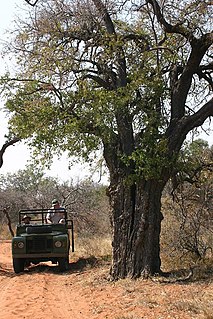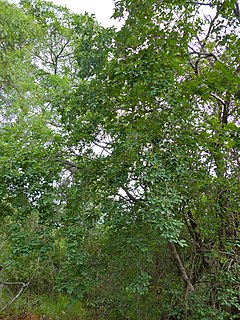Discoclaoxylon is a plant genus of the family Euphorbiaceae, first described in 1914. It is native to western and central Africa, including islands in the Gulf of Guinea.
- Discoclaoxylon hexandrum(Müll.Arg.) Pax & K.Hoffm. - Ghana, Guinea, Ivory Coast, Sierra Leone, Nigeria, Cameroon, Gabon, Central African Republic, Equatorial Guinea, São Tomé, Congo-Brazzaville, Zaire, Uganda
- Discoclaoxylon occidentale(Müll.Arg.) Pax & K.Hoffm. - São Tomé
- Discoclaoxylon pedicellare(Müll.Arg.) Pax & K.Hoffm. - Bioko
- Discoclaoxylon pubescens(Pax & K.Hoffm.) Exell - Annobón
Mareya is a plant genus of the family Euphorbiaceae, first described as a genus in 1860. It is native to tropical western and central Africa.
Mareyopsis is a plant genus of the family Euphorbiaceae first described as a genus in 1919. It is native to western and central Africa.
- Mareyopsis longifolia(Pax) Pax & K.Hoffm. - Nigeria, Cameroon, Gabon, Equatorial Guinea, Congo-Brazzaville, Zaire
- Mareyopsis oligogynaBreteler - Gabon
Seidelia is a plant genus of the family Euphorbiaceae first described as a genus in 1858. The genus is endemic to Southern Africa.
- Seidelia firmula(Prain) Pax & K.Hoffm - Namibia, Cape Province
- Seidelia triandra(E.Mey.) Pax - Namibia, Cape Province, Free State
Discocleidion is a plant genus of the family Euphorbiaceae first described as a genus in 1914. It contains one accepted species, Discocleidion rufescens, endemic to China.
Paranecepsia is a plant genus of the family Euphorbiaceae first described as a genus in 1976. It contains only one known species, Paranecepsia alchorneifolia, native to southeastern Africa.
Astrococcus is a genus of plant of the family Euphorbiaceae first described as a genus in 1854. It contains only one known species, Astrococcus cornutus, native to neighboring states of identical names, Amazonas State in southern Venezuela and Amazonas State in northwestern Brazil.
Haematostemon is a genus of plant of the family Euphorbiaceae first described as a genus in 1919. It is native to northeastern South America.
- Haematostemon coriaceus(Baill.) Pax & K.Hoffm. - Amazonas State in S Venezuela
- Haematostemon guianensisSandwith - Potaro-Siparuni region of Guyana
Tragiella is a genus of plant of the family Euphorbiaceae first described as a genus in 1919. It is native to Africa.
- Tragiella anomala(Prain) Pax & K.Hoffm. - Tanzania, Malawi, Zambia
- Tragiella frieseana(Prain) Pax & K.Hoffm. - Zambia
- Tragiella natalensis(Sond.) Pax & K.Hoffm. - South Sudan, Kenya, Tanzania, Uganda, Malawi, Mozambique, Zimbabwe, Cape Province, KwaZulu-Natal, Limpopo, Mpumalanga
- Tragiella pyxostigmaRadcl.-Sm. - Tanzania
Argomuellera is a genus of plant of the family Euphorbiaceae first described as a genus in 1894. It is native to sub-Saharan Africa, Madagascar, and the Comoros Islands.
Cavacoa is a plant genus of the family Euphorbiaceae first described as a genus in 1955. All the species are native to sub-Saharan Africa.
- Cavacoa aurea(Cavaco) J.Léonard - Kenya, Malawi, Mozambique, KwaZulu-Natal
- Cavacoa baldwinii(Keay & Cavaco) J.Léonard - Sierra Leone, Liberia
- Cavacoa quintasii(Pax & K.Hoffm.) J.Léonard - Annobón, São Tomé, Zaïre
Grossera is a plant genus of the family Euphorbiaceae first described as a genus in 1903. It is native to Madagascar and to mainland tropical Africa.
- Grossera angustifoliaBarbera&Riina - Equatorial Guinea
- Grossera elongataHutch. - Príncipe
- Grossera glomeratospicataJ.Léonard - East Congo
- Grossera macranthaPax - East Congo, West Congo, Cameroon, Central African Rep.
- Grossera majorPax - Cameroon
- Grossera multinervisJ.Léonard - East Congo, São Tomé
- Grossera paniculataPax - West Congo, Cameroon, Gabon
- Grossera perrieriLeandri - Madagascar
- Grossera vigneiHoyle - Ivory Coast, Ghana, West Congo
Tannodia is a plant genus of the family Euphorbiaceae first described as a genus in 1861. It is native to Africa, Madagascar, and Comoros.
- Tannodia congolensis - Zaïre
- Tannodia cordifolia - Comoros, Madagascar
- Tannodia grandiflora - Diana Region in Madagascar
- Tannodia nitida - Atsinanana in Madagascar
- Tannodia obovata - Atsinanana in Madagascar
- Tannodia pennivenia - Atsinanana in Madagascar
- Tannodia perrieri - Madagascar
- Tannodia swynnertonii - Tanzania, Mozambique, Zimbabwe
- Tannodia tenuifolia - Kenya, Tanzania, Malawi, Mozambique, Zimbabwe, Zambia
Neoboutonia is a plant genus of the family Euphorbiaceae first described as a genus in 1864. It is the only genus in subtribe Neoboutoniinae, and native to tropical Africa.
- Neoboutonia macrocalyx Pax - Burundi, Cameroon, Rwanda, Zaire, Kenya, Tanzania, Uganda, Malawi, Zambia, Zimbabwe
- Neoboutonia manniiBenth. & Hook.f. - tropical Africa from Liberia to Mozambique
- Neoboutonia melleri(Müll.Arg.) Prain - tropical Africa from Nigeria to Mozambique
Dodecastigma is a genus of plants under the family Euphorbiaceae first described as a genus in 1932. It is native to northern South America.
- Dodecastigma amazonicumDucke - Amazonas State in Brazil
- Dodecastigma integrifolium(Lanj.) Lanj. & Sandwith - French Guiana, Guyana, N Brazil
- Dodecastigma uleanum(Pax & K.Hoffm.) G.L.Webster - Amazonas, Amapá
Mildbraedia is a plant genus of the family Euphorbiaceae first described as a genus in 1909. The entire genus is native to Africa.
- Mildbraedia carpinifolia – Kenya, Tanzania, Mozambique
- Mildbraedia klaineana – Republic of the Congo, Democratic Republic of the Congo, Cabinda, Gabon
- Mildbraedia paniculata – Democratic Republic of the Congo, Gabon, Ghana, Ivory Coast, Liberia
Dichostemma is a flowering plant genus in the family Euphorbiaceae first described as a genus in 1896. It is native to tropical western and central Africa.
- Dichostemma glaucescensPierre - Nigeria, Cameroon, Gabon, Republic of the Congo, Central African Republic, Cabinda, Democratic Republic of the Congo
- Dichostemma zenkeriPax - Cameroon

Spirostachys is a plant genus of the family Euphorbiaceae first described as a genus in 1850. It is native to Africa. Zuloaga, F. O., O. Morrone, M. J. Belgrano, C. Marticorena & E. Marchesi. (eds.) 2008. Catálogo de las plantas vasculares del Cono Sur. Monographs in systematic botany from the Missouri Botanical Garden 107(1–3): i–xcvi, 1–3348.

Pseudolachnostylis is a genus of plants in the family Phyllanthaceae first described as a genus in 1899. It contains only one known species, Pseudolachnostylis maprouneifolia native to central and southern Africa. Its common name is kudu berry, though the term also applies for Cassine aethiopica.
Chonocentrum is a genus of the family Phyllanthaceae described as a genus in 1922. It contains only known species, Chonocentrum cyathophorum, native to the State of Amazonas in northwestern Brazil.

